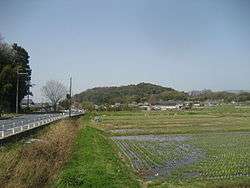Kunimi (practice)

The ancient Japanese practice of kunimi (国見), lit. "viewing the realm", involved climbing a mountain to survey the land, often before praising it in song. It is documented in the early chronicles the Kojiki and Nihon Shoki as well as in a number of poems in the Man'yōshū.[1]
Origins
Close association with the Imperial House may suggest that kunimi was an agricultural rite imported from China; alternatively it may have been a folk practice.[1] The "blood relationship" between emperor and land gives kunimi added significance.[2] The earliest documented occurrence was in 663 BC, when Emperor Jimmu ascended a mountain in Uda and spotted eighty bandits on Kunimi Hill; he is advised by the kami to subdue them by gathering clay from Mount Kagu and creating from it sacred vessels for propitiatory sacrifice accompanied by incantation.[1] In 630 Jimmu himself ascended the hill of Wakigami no Hohoma no Oka, viewed the land, and observed: "Oh! what a beautiful country we have become possessed of! Though a blessed land of inner-tree-fibre, yet it resembles a dragon-fly licking its hinder parts".[1] The imperial excursions of Emperor Ōjin and Emperor Yūryaku also led to kunimi.[1]
Man'yōshū
There are a number of kunimi uta or land-viewing poems in the Man'yōshū, including MYS 1: 2 by Emperor Jomei:[1][3]
Countless are the mountains in Yamato,
But perfect is the heavenly hill of Kagu;
When I climb it and survey my realm,
Over the wide plain the smoke-wreaths rise and rise,
Over the wide lake the gulls are on the wing;
A beautiful land it is, the Land of Yamato!
See also
References
- 1 2 3 4 5 6 Ebersole, Gary L. (1989). Ritual Poetry and the Politics of Death in Early Japan. Princeton University Press. pp. 23–30. ISBN 978-0-6910-1929-1.
- ↑ Keene, Donald (1988). The Pleasures of Japanese Literature. Columbia University Press. p. 57. ISBN 0-231-06736-4.
- ↑ Nippon Gakujutsu Shinkōkai, ed. (1940). The Manyoshu: One Thousand Poems Selected and Translated from the Japanese. Iwanami Shoten.